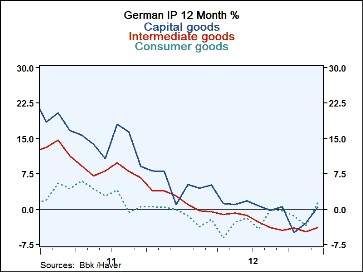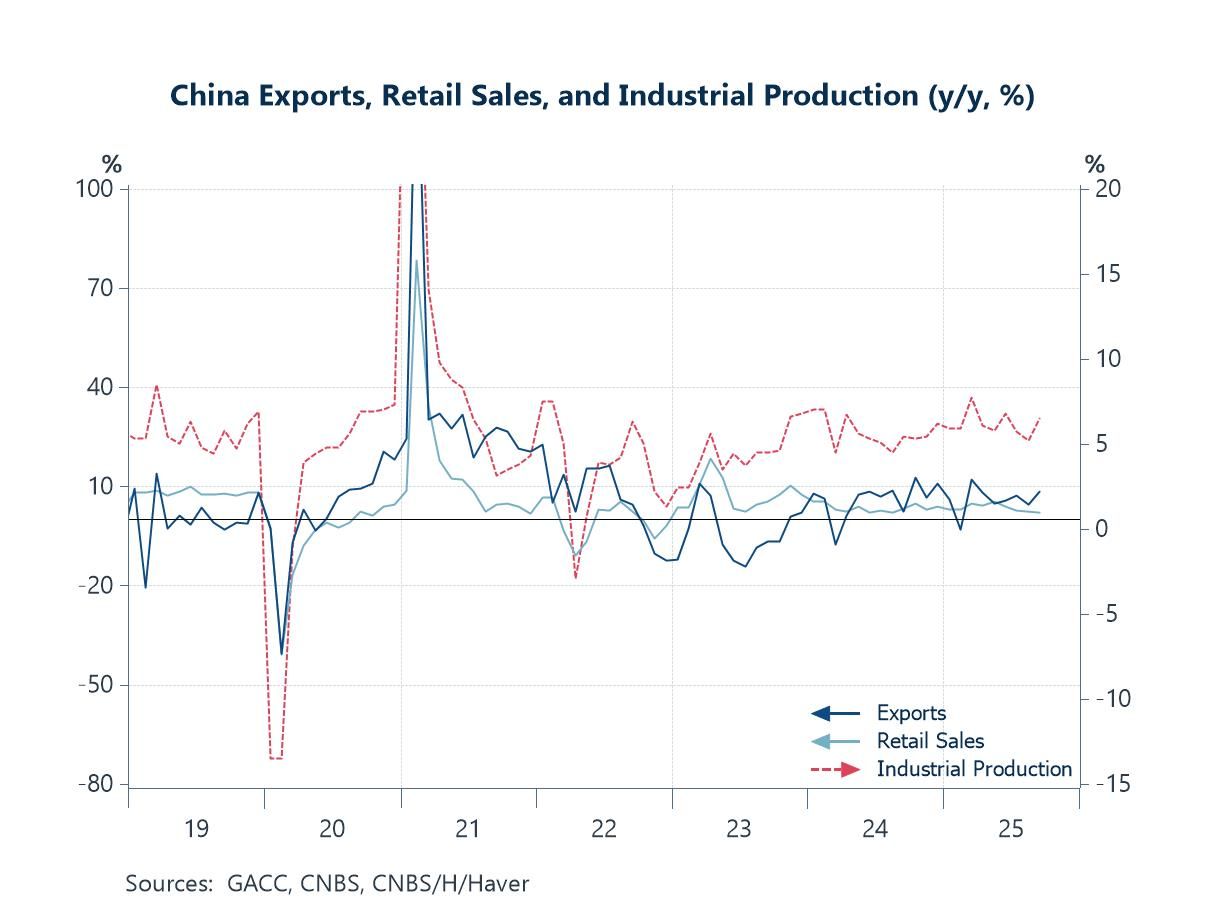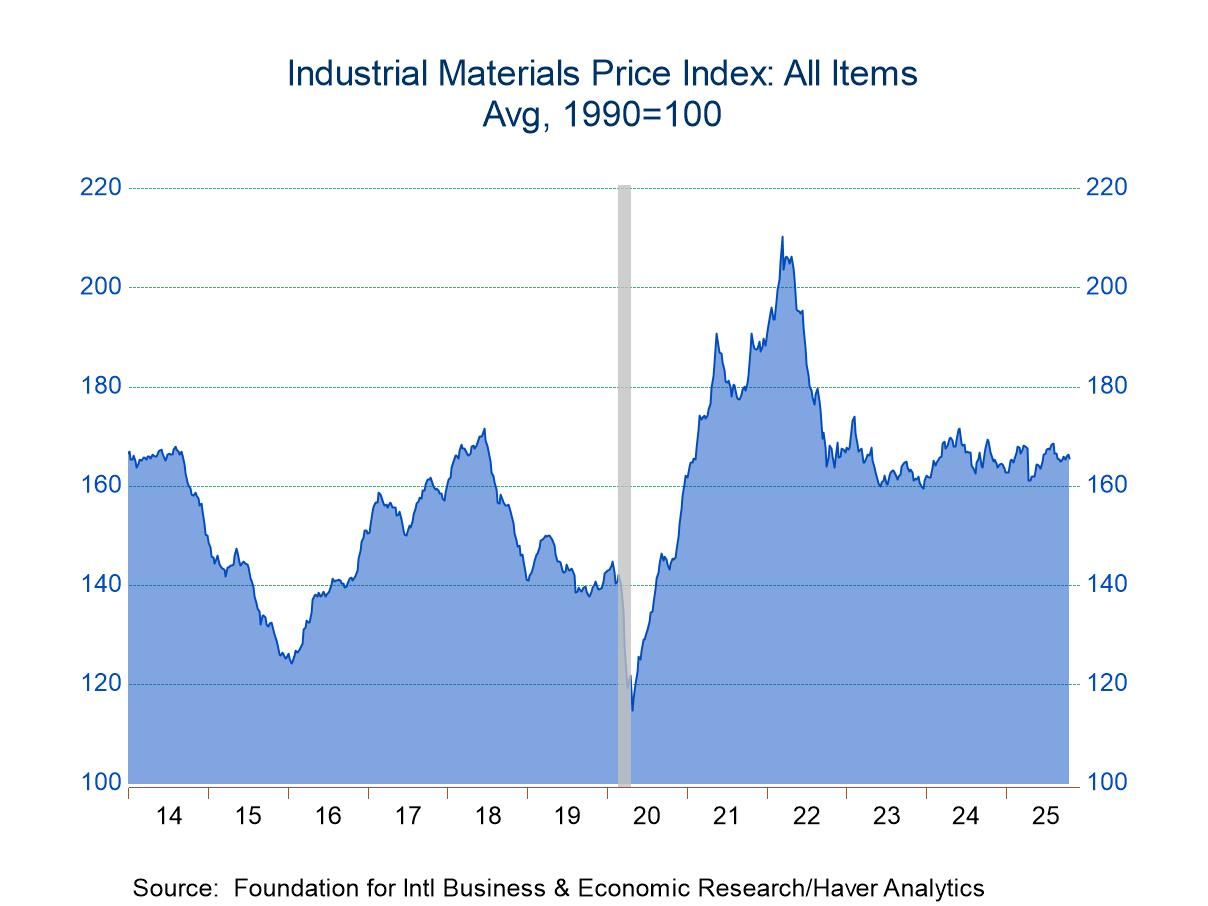 Global| Feb 07 2013
Global| Feb 07 2013German IP Rises but the Quarter is Lost but Next Year's Q1 May be a Gain!
Summary
German IP struggled to a gain in December rising by 0.3% after four straight months of decay. However, there are some seeds of hope for Q1 growth. While there is only one month of gain in the quarter it came at the quarter's end. The [...]
 German IP struggled to a gain in December rising by 0.3% after four straight months of decay. However, there are some seeds of hope for Q1 growth. While there is only one month of gain in the quarter it came at the quarter's end. The biggest negative pulse for Germany came at the quarter's start. Since the December rise exceeds the November drop by a good margin, the December level for IP actually sits above the Q4 average. IP is growing at a 0.7% annual rate relative to its Q4 average if it were to stay at this level in January. That means that IP actually has some positive momentum heading into January despite the bleak string of numbers (see the table). If it is flat month-to-month it still grows quarter-to-quarter.
German IP struggled to a gain in December rising by 0.3% after four straight months of decay. However, there are some seeds of hope for Q1 growth. While there is only one month of gain in the quarter it came at the quarter's end. The biggest negative pulse for Germany came at the quarter's start. Since the December rise exceeds the November drop by a good margin, the December level for IP actually sits above the Q4 average. IP is growing at a 0.7% annual rate relative to its Q4 average if it were to stay at this level in January. That means that IP actually has some positive momentum heading into January despite the bleak string of numbers (see the table). If it is flat month-to-month it still grows quarter-to-quarter.
Capital goods have a strong positive pulse for Q1, despite their -16.7% annual rate drop in Q4. This owes to the rise in output in November and in December after a very sharp fall in October to start the quarter. Capital goods output in December implies January growth at a stunning 12.1% annual rate over the Q4 average if output is flat December to January.
Consumer goods output fell at a 2.7% rate in Q4 but it also has a positive push to begin Q1 of 2013.
Intermediate goods are the exception. Output of intermediate goods fell at a 10.5% pace in Q4 and that continued to drop during each month in the quarter. This sector starts out Q1 of 2013 in the hole with a negative rate of growth of -5.1% annualized relative to the Q4 average, on the assumption of flat IP in January (carrying the December level forward).
Interestingly the pattern for German industrial output is superior to the pattern for real MFG orders. MFG output is actually moving ahead into Q1 at a faster pace than orders. Orders are barely above their Q4 average as of December, growing at a 0.3% annual rate in an implied flat January over their Q4 base (average).
Spain, Ireland and the UK share this pattern with Germany; each shows a rise of IP in December. But Ireland and the UK had drops in November like Germany. Ireland shows two gains in a row in output. Spain's November drop was large so it is looking a December level that implies a shrinking for and unchanged level of output in January at a -2.6% annual rate relative to its Q4 average despite a December gain month-to-month. But the UK joins Germany with positive momentum in Q1 (and Ireland, of course) on a relatively strong December reading.
Germany is not alone in trying to start the New Year with some positive momentum on the industrial side. These are calculations from the real output side not from PMI diffusion data. Although it looks not so strong on the face of it, the turn could be significantly better, as the above calculations suggest because of the unique timing for the bottoming in output at the very middle of the fourth quarter...if output continues to press ahead with its gains and if it has in fact bottomed. That much is still speculative.
| Total German IP | Quarter | ||||||
|---|---|---|---|---|---|---|---|
| SAAR except M/M | Dec-12 | Nov-12 | Oct-12 | 3-mo | 6-mo | 12-Mo | to-Date |
| IP Total | 0.3 | -0.2 | -2.0 | -7.3 | -4.8 | -1.1 | -11.3 |
| Consumer | 3.9 | -2.3 | -1.1 | 2.0 | 2.2 | 1.3 | -2.7 |
| Capital | 1.9 | 2.0 | -4.1 | -1.4 | 0.5 | 0.3 | -16.3 |
| Intermediate | -0.7 | -1.2 | -0.1 | -7.7 | -9.7 | -3.8 | -10.5 |
| MEMO: | -8.9 | 1.3 | -1.6 | -32.0 | -14.4 | -5.6 | -11.0 |
| Construction | -8.9 | 1.3 | -1.6 | -32.0 | -14.4 | -5.6 | -11.0 |
| MFG IP | 1.2 | 0.0 | -2.0 | -3.5 | -3.3 | -1.1 | -11.7 |
| Real MFG Orders | 0.8 | -1.8 | 0.0 | 11.8 | -1.1 | -1.8 | 4.0 |
| Spain | 3.3 | -6.1 | 0.0 | 2.7 | -6.3 | -5.9 | -9.8 |
| Ireland | 8.5 | 0.2 | 0.0 | 58.3 | -4.8 | 1.6 | -14.4 |
| Portugal | -1.3 | -3.2 | 0.1 | 3.5 | -8.4 | -4.1 | -13.9 |
| UK: EU Member | 1.6 | -0.4 | 0.0 | -0.4 | 3.6 | -1.5 | -5.2 |
Robert Brusca
AuthorMore in Author Profile »Robert A. Brusca is Chief Economist of Fact and Opinion Economics, a consulting firm he founded in Manhattan. He has been an economist on Wall Street for over 25 years. He has visited central banking and large institutional clients in over 30 countries in his career as an economist. Mr. Brusca was a Divisional Research Chief at the Federal Reserve Bank of NY (Chief of the International Financial markets Division), a Fed Watcher at Irving Trust and Chief Economist at Nikko Securities International. He is widely quoted and appears in various media. Mr. Brusca holds an MA and Ph.D. in economics from Michigan State University and a BA in Economics from the University of Michigan. His research pursues his strong interests in non aligned policy economics as well as international economics. FAO Economics’ research targets investors to assist them in making better investment decisions in stocks, bonds and in a variety of international assets. The company does not manage money and has no conflicts in giving economic advice.






